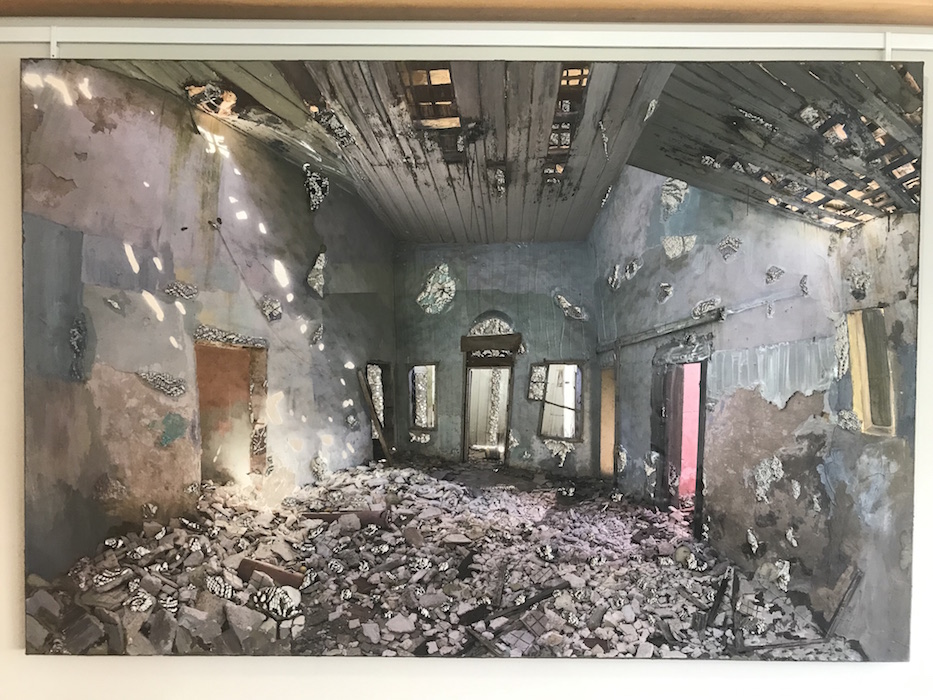
Beth El Keser Israel | Faith & Spirituality | Arts & Culture | Westville
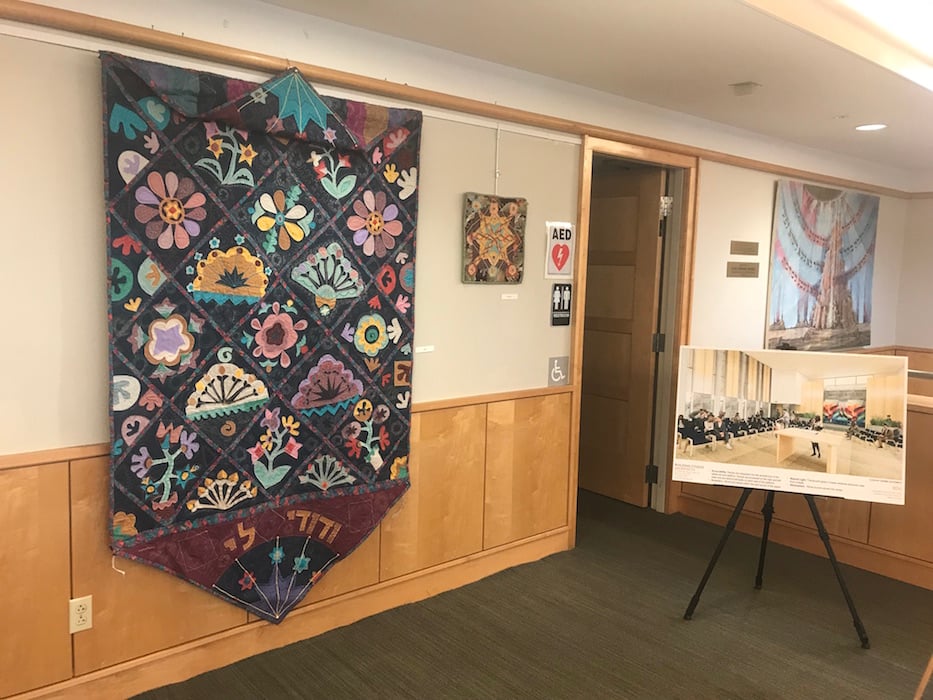
Naomi Safran-Hon Going Home and Suzanne Neusner’s Fiber Arts are on view at BEKI through June 4 and June 28 respectively. Al Larriva-Latt Photos.
Upstairs at Congregation Beth El–Keser Israel, there is a long hallway where over a dozen handmade quilts of various shapes and sizes blanket the walls. They extend from the hallway into the main lobby, where they drape above the cushy brown couches.
Below, on the basement level, hang five canvases so large and captivating they seem to become a part of the wall itself.
In the upstairs and downstairs exhibition spaces of the synagogue, Naomi Safran-Hon’s Going Home and Suzanne Neusner’s Fiber Arts are on view through June 4 and June 28 respectively. Both start from materials-oriented approaches to bring about larger questions of home.
Non-members of Beth El–Keser Israel (BEKI) can RSVP to see the show by emailing office@beki.org. The synagogue is located at 85 Harrison St. in New Haven’s Westville neighborhood.
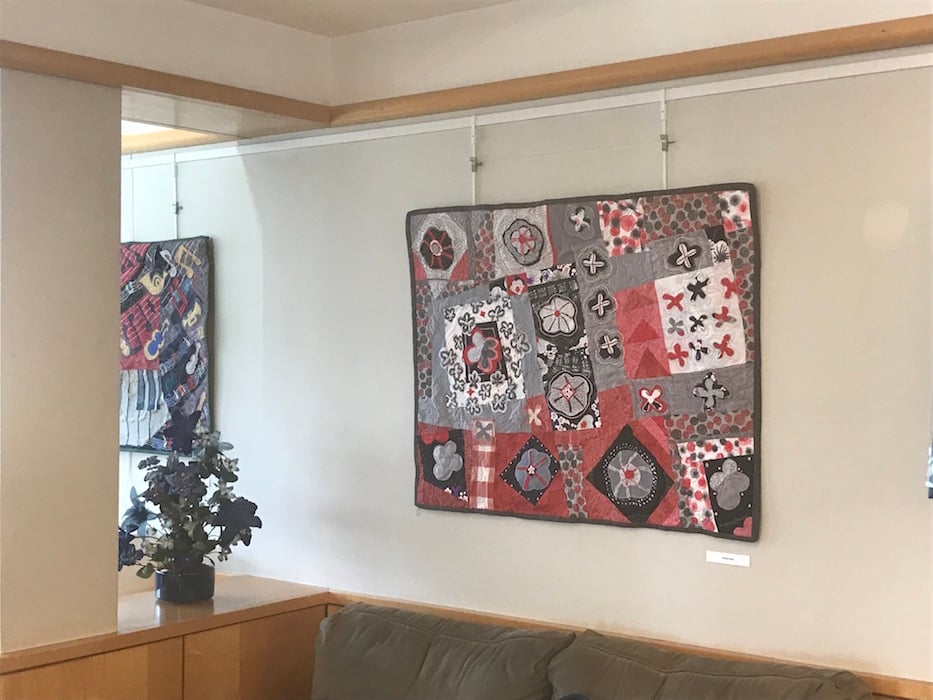
In Fiber Arts, Neusner translates and transforms her natural landscape in the Hudson Valley into abstract forms and motifs.
Hanging amidst the couches of the main lobby and abutting two sanctuary spaces, Neusner’s work bursts with bold colors, idiosyncratic shapes, and an affinity for pushing the boundaries of fiber arts. Although weaving and quilting have been her focus for the past 35 years, the artist has worked in a variety of media, including painting, printmaking, and stained glass. In Fiber Arts, she translates and transforms her natural landscape in the Hudson Valley into abstract forms and motifs.
As one roves from across the first-floor exhibition space, Nausner’s experimentation with various media emerges. She sews fabric into complex matrices of shape, line, and color, creating complex patterns and dense compositions.
The three-dimensionality of her work is apparent. In the rectangular quilted work "Introspection," the scalloped edges of the frame billow outward toward the viewer. In the center of the quilt is the silhouette of a human head and torso, which appears to take shelter within the private and intimate space of the frame.
On the opposite wall of the hallway-turned-gallery-space, Neusner takes this three-dimensionality event further. In the multi-paginated quilt "The Book of Life," three quilted pages unfurl from the quilted “back cover” of the book, casting a slight shadow over the gallery wall. The pages are thick, padded, and adorned with cut-outs of flowers and leaves. With the basic material of thread, Neusner infuses domestic objects with religious meaning and vice versa.
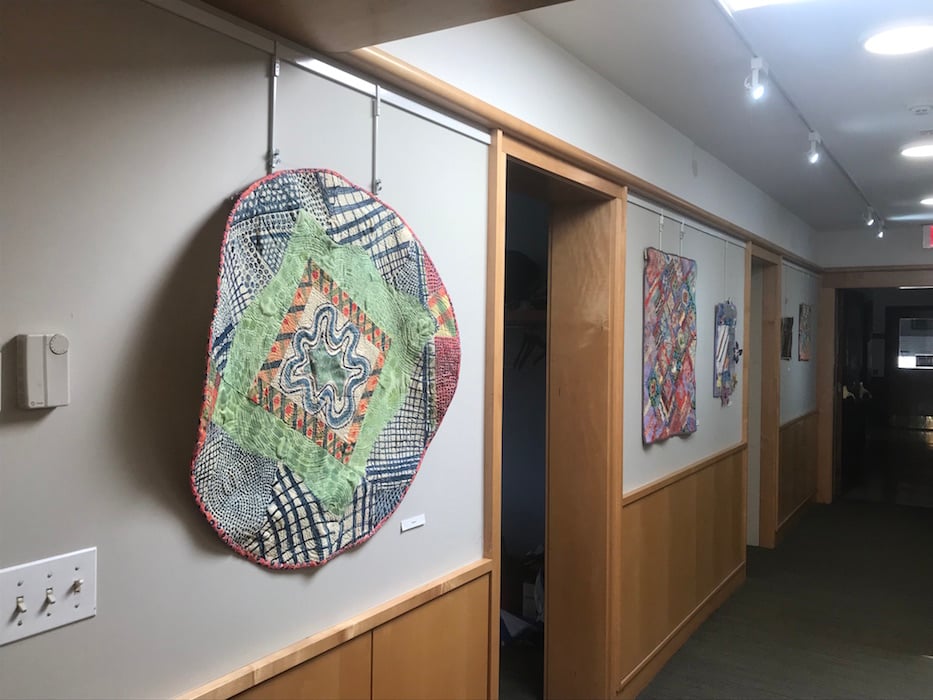
"Coaster."
This three-dimensionality continues in the circular quilt "Coaster." The center is anchored by an amoeba-like abstraction with wavy appendages. Hand-painted dots of various colors and sizes freckle the fabric, conjuring microscopic cells or droplets of water. Concentric circles, embroidered onto the fabric, cascade toward the quilt’s round edge, mimicking the motion of a pond or lake. "Coaster" becomes a cross section of a watery habitat in the Hudson River Valley.
While nature reverberates within the quilt, so too, does Judaism. The lattice of circles and dots produces a texture similar to that of unleavened bread. The circular body of the quilt, which bends and folds as it hands from its wall mount, recalls the round matzah at Passover.
The quilt "Coaster" is multi-function. All at once, it is a functioning household object, a meditation on nature, and an evocation of Judaism—mingling and mutually reinforcing its various uses.
Down the wide spiral staircase is the lower level of the synagogue. A foyer doubles as an exhibition space. Through an open doorway is the downstairs social hall, where tables and chairs stretch across the room. Here is where Jewish life continues, where brunches are held, milestones marked, and b’nei mitzvot celebrated.
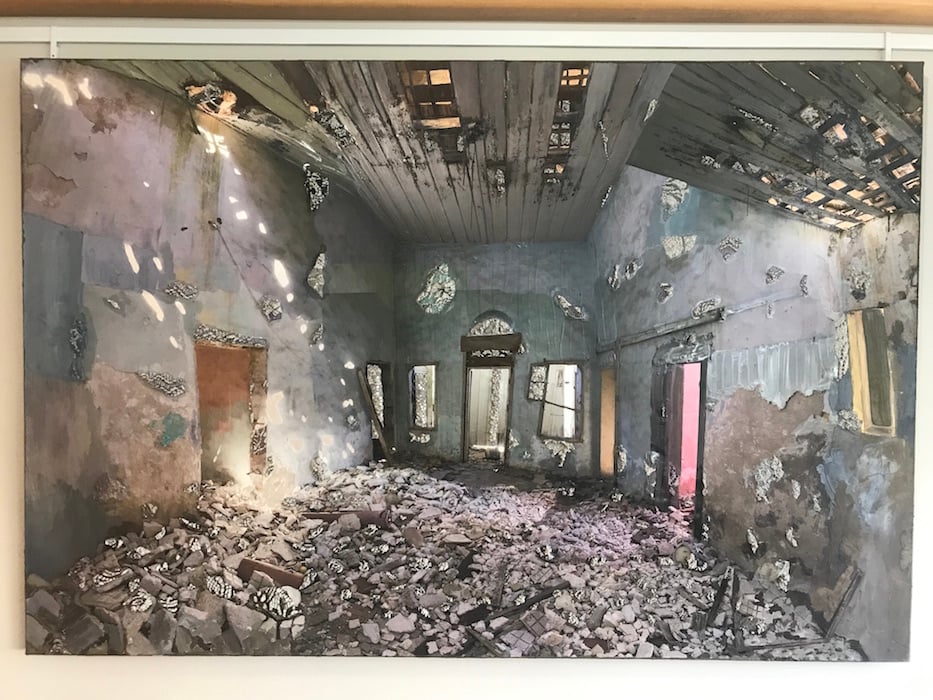
"The Memory of a Shifting Ceiling," 2019. Acrylic, goache, cement, archival inkjet on canvas.
And yet the walls of the lower-level foyer—upon which hang five large-scale mixed media paintings—are choked with concrete rubble and the sight of decay (one other painting hangs in the front lobby).
Naomi Safran-Hon grew up in Haifa before moving to the United States, where she was trained at Brandeis and the Yale School of Art. Her exhibition Going Home centers the historic neighborhood of Wadi Salib in Haifa—itself an area that some artists, and many displaced people, still refer to as part of Palestine. The United Nations first designated it as part of an official Jewish state in 1947.
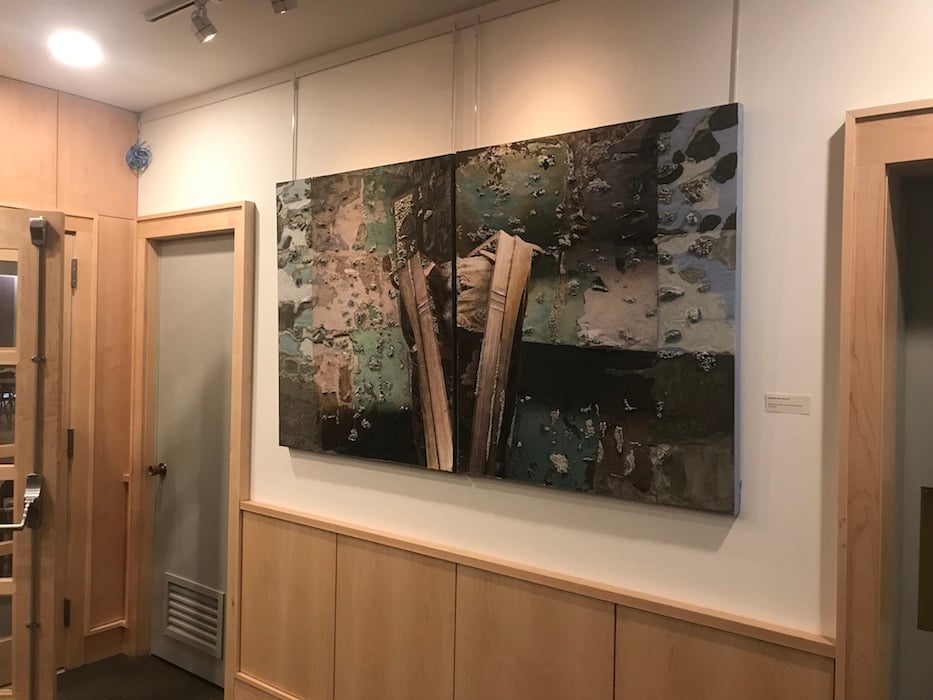
"Wadi Salib: Mirror Bed," 2014. Archival ink jet print, lace and cement on fabric and canvas.
Like Neusner, Safran-Hon’s practice is fascinated by the material. She takes documentary-style photographs of the remnants of Wadi Salib homes and blows the photographs up into massive inkjet prints. She coats the surface of the photograph with concrete, as one might reinforce a wall of a house, and stacks particles of concrete particles into stalactite-like formations. She also stretches lace across the photograph’s surface.
The result is a collection of pieces that probe the boundary between content and form.
The diptych “Wadi Salib: Mirror Bed” hangs on the wall closest to the meeting hall. The scene is zoomed into, blown up, difficult to discern at first. In the center, making use of the pre-existing gap between the edge of the two canvases, lies a mattress that has been riven apart. The bed frames are horizontal, teeter and lurch away from another, bending backwards at toward the opposite edges of the frame. Material—cotton stuffing, wood slats, fiber—groans across the crack.
The space around the beds carries the shockwaves of the rupture. Sculptural accretions of concrete radiate from the center toward the canvas’ edges. Mottled colors shudder across the two canvases, where gunmetal gray peels into an earthy green. The pattern recalls military camouflage or a gnarly, years-in-the-making formation of mold. There is a finality to the rupture--a sense of the broken pieces will continue to burst apart in increasing entropy.
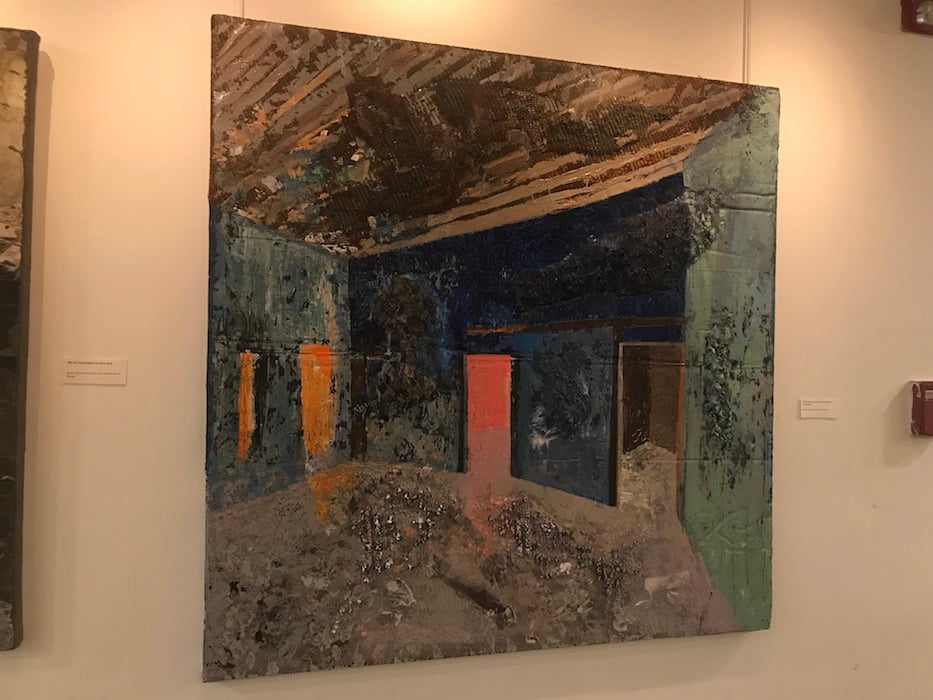
"Three doors into my blue heart in pink and orange," 2018. Acrylic paint, cement and lace on canvas.
She echoes this surrealism in “Three doors into my blue heart in pink and orange.” The top right corner, the ceiling of a house swells outward. It is textured and three-dimensional and seems to physically lurch into the exhibition space. The three walls of the room gleam in gunmetal gray, aquamarine blue, and a shade of green that spells decay.
From the two empty doorways gleams orange and pink in haunting hues—of sunset, neon—that spill light, warm, unsettling, urgent, into the room. There is a restless stasis in the rooms, the intensity of absence. It is a painting that must be spent time with, allowed to seep into one’s pores, until it saturates the space of the exhibition gallery, and becomes inseparable with the present reality. Safran-Hon is bringing the decay of broken Israeli-Palestine relations into the synagogue, rupturing the sacred and communal space of home.
The "my” in the painting’s title “Three doors into my blue heart in pink and orange” personalizes the destruction in Wadi Salib, asserting the shared impact of the events in Wadi Salib on Safran-Hon’s own life. The houses are not only physical structures, but bodies, organs of people.
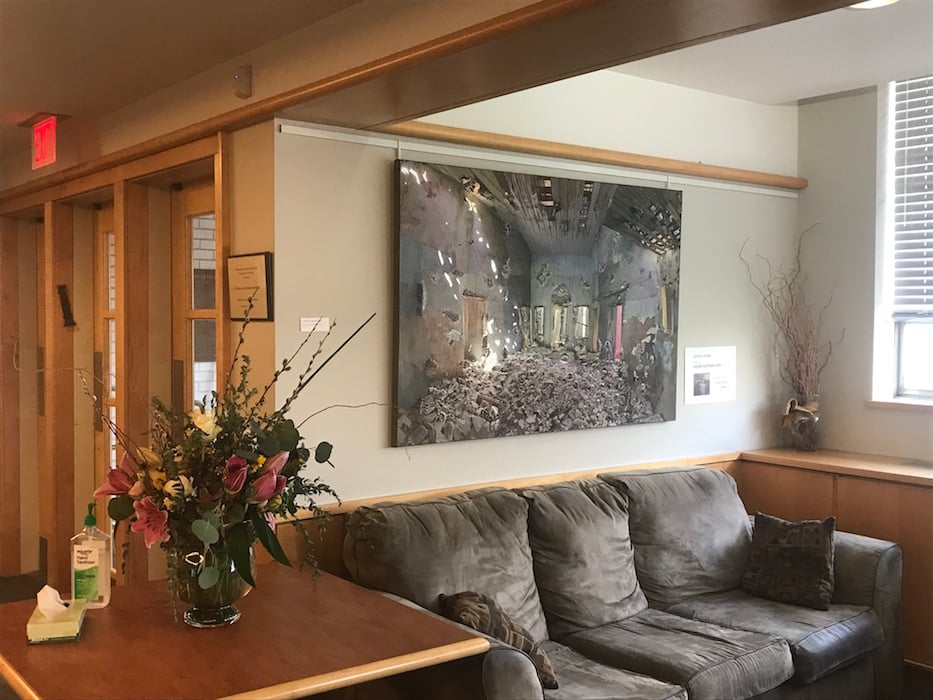
"The Memory of a Shifting Ceiling," 2019, acrylic, goache, cement, archival inkjet on canvas.
In a painting on the top floor, entitled “The Memory of a Shifting Ceiling,” Safran-Hon moves toward realism. There is the interior of a house, cavernous and high-ceilinged. Light seeps in through the gap-toothed roof, suffusing the room with light. Chunks of concrete are strewn the floor, forming a kind of barbed and tangled rug. In the far reaches of the walls are Safran-Hon’s signature doors (reappearing from the “Three doors into my heart”), emanating a soft urgent glow onto the ruined floor.
In the methods of mixing cement like a construction worker, Safran-Hon has spread concrete along sections of the left wall, adding to the motley of color. The walls rise powerfully from the foundation, steady and upright and seeming to defy the weight of the concrete that Safran-Hon has affixed to the walls. Despite the remnants of violence, displacement, and death, there is a kind of bewildering beauty to the scene. The scene is also suffused with a kind of reeling unease.
Safran-Hon’s pieces thus face the same challenge of the exhibition text: is the haunting evoked by the landscapes sufficient to bring to mind the people at the center of the conflict? Safran-Hon’s exhibition skillfully brings this tension to light.
Non-members of Beth El–Keser Israel (BEKI) can RSVP to see the show by emailing office@beki.org. The synagogue is located at 85 Harrison St. in New Haven’s Westville neighborhood.

